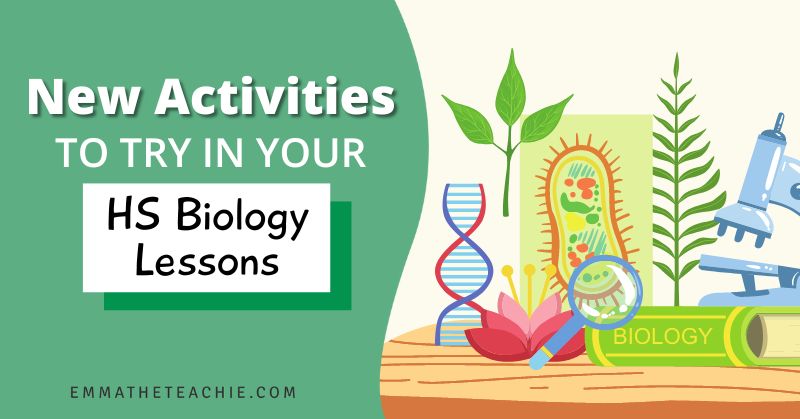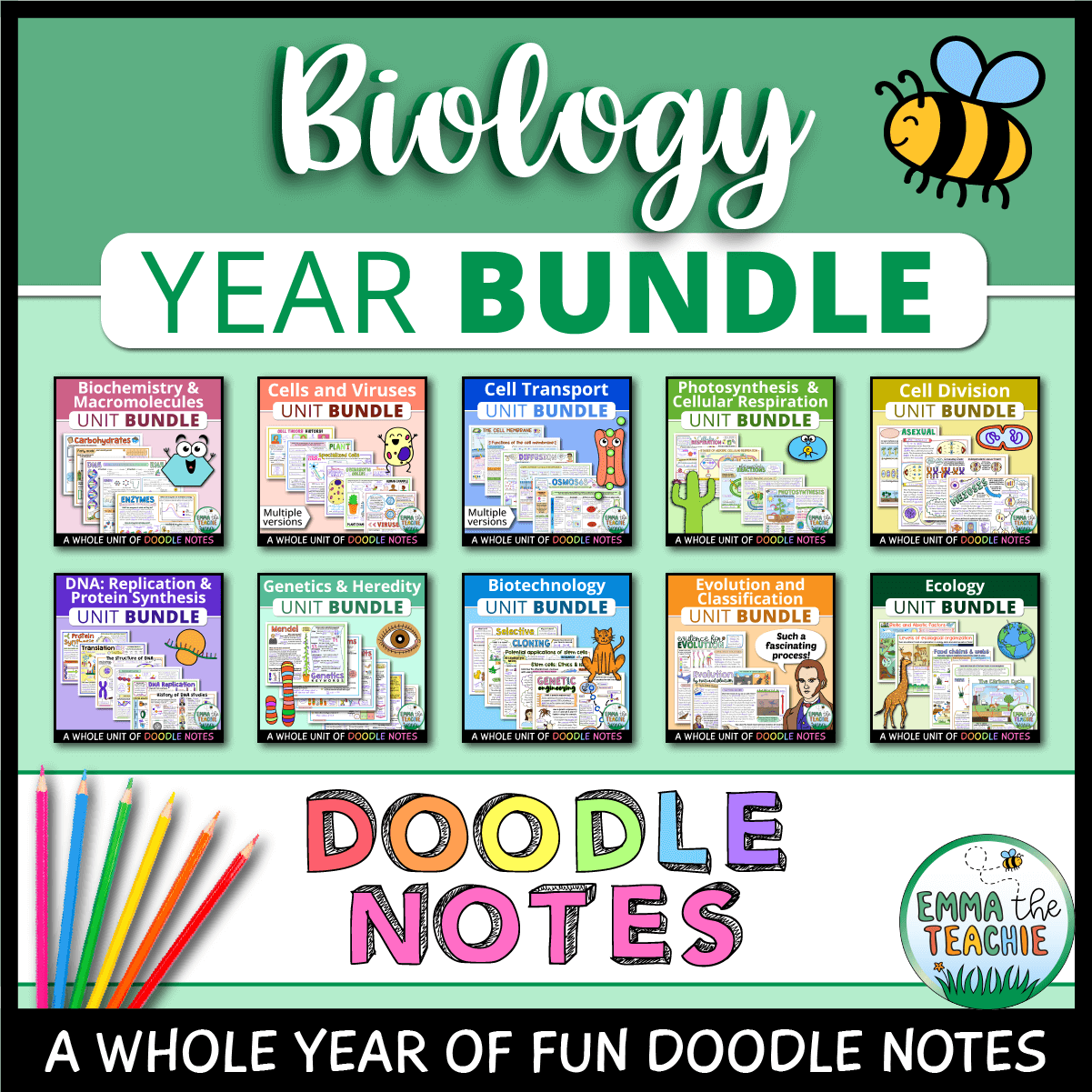
New Activities to try in your High School Biology Lessons this Year
It’s a new year, which means it’s a great time to try new activities in your high school biology lessons!
I love to implement new ideas and see how students react and learn.
We are constantly seeking innovative ways to engage our students and enhance their learning experience. Why not spice up your biology lessons with some exciting activities that will not only captivate your students’ attention but also promote active learning?
Let’s explore four engaging activities to consider incorporating into your high school biology classroom:
- Digital quiz games
- Doodle Notes
- Interactive notebooks (both digital and paper)
- Escape rooms!

Digital Quiz Games
Are you trying to find new and engaging ways to review important concepts with students?
Digital quiz games are fantastic for reviewing biology concepts!
The possibilities are literally endless. Some of the popular platforms include Kahoot!, Quizizz, and Gimkit. These interactive sites allow you to create customized quizzes that can be played as a class or individually.
Your students will love the competitive elements, such as leaderboards and timers. We all know that students LOVE to compete with one another.
Did I also mention that these tools are easy to use?
All you need to do is select a specific unit or topic to focus on. Then, create engaging and challenging questions that cover key concepts within those topics. You can include multiple-choice, true/false, and even open-ended questions to encourage critical thinking.
If you want to make it even more interesting, use multimedia elements, such as images or videos, to make the quizzes more visually appealing and interactive.
Once you’ve created the content part, allow students to play these quizzes on their own devices, such as smartphones or tablets, or use classroom technology like interactive whiteboards. These tools not only foster active participation, but also creates a sense of excitement and engagement among students.
Want to learn more about digital quiz games? You can read my previous blog post on review activities here.

Doodle Notes
If you’ve been around for a while, you know I love Doodle Notes. They may be my favorite aspect of my classroom.
If you’re new, check out my blog post on why I love Doodle Notes here.
Doodle Notes are an excellent activity for visual learners and can help students better retain and understand complex biological concepts. Encourage students to sketch and annotate their notes by providing them with structured templates or guiding prompts.

To introduce Doodle Notes, provide students with handouts that feature visually appealing diagrams or illustrations related to the topic you are teaching. Encourage them to personalize their notes by adding colors, symbols, and creative annotations that highlight key information.
You can use Doodle Notes in a variety of ways. Doodle Notes can be used to launch a topic, as a review, sub plan, etc.
These visually engaging notes not only make the learning process more enjoyable but also serve as a valuable study resource for students.
Students can study their Doodle Notes before exams or quizzes, which will reinforce the content.
Have I intrigued you yet?
If I have, you can browse the Doodle Notes I have created here.
Interactive Notebooks
Interactive notebooks, whether digital or paper-based, offer an engaging way for students to organize and interact with their biology content.
If the interactive notes are done on paper, students can paste or draw diagrams, write summaries, and even create foldables to reinforce key concepts.
To implement paper-based interactive notebooks, provide students with a designated notebook or binder. Teach them how to organize their notes by using tabs or dividers to separate different topics or units. Be sure to have students include a Table of Contents so they can easily locate information.
For digital interactive notebooks, interactive Google Slides are a great tool. This format allows for easy customization and collaboration among students. Google Slides also allow you, the teacher, to easily differentiate learning materials for students.
If you want to check out the interactive Google Slides I have created, click here.
As a whole, interactive notebooks encourage active learning and serve as excellent study tools. This would be an excellent activity to try in the new school year.

Escape Rooms
If you really want to get students excited, try implementing an escape room!
Not only will students be excited, but you will be fostering critical thinking in your classroom. Tap into your creative side and design a variety of puzzles, riddles, and challenges that revolve around biology concepts and require students to apply their knowledge to solve them.
Within a biology unit, identify key concepts, vocabulary, and processes, and brainstorm ways to incorporate them into puzzles and challenges.
For example, if you are teaching about cellular respiration, you could create puzzles that involve decoding enzyme names, matching metabolic pathways to their products, or solving a riddle related to the role of mitochondria.
Set up different stations in your classroom. The individual stations will each have a unique puzzle or challenge. Provide students with clues or hints that lead them from one station to another, ultimately guiding them towards the ultimate goal of “escaping” the room.
As students solve each puzzle or challenge, they will receive a clue to unlock the next station.
Encourage collaboration and critical thinking as students work together to decipher the clues and apply their biology knowledge to progress through the escape room.
Escape rooms not only make learning biology more interactive and engaging but also foster teamwork, problem-solving skills, and perseverance among students!

The only failure is not trying
Incorporating new activities into your high school biology lessons can be scary, but can also revolutionize the learning experience for your students.
By incorporating new activities into your curriculum, you can create a more captivating and immersive learning experience that fosters deeper understanding and long-term retention of biology concepts.
So, why not make this year the year of innovation for your biology lessons? Your students will thank you for it!
Take action: choose one type of new activity to try out in your lessons this week.
Have a wonderful day,







